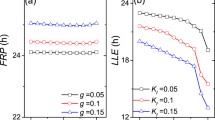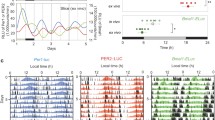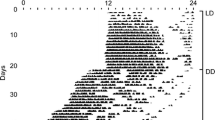Summary
The effects on activity rhythms of a daily 30 min opportunity to leave the home cage and hoard seeds from an open field were assessed in Syrian hamsters housed in continuous dim illumination. Six of ten hamsters responded with clear entrainment of their activity rhythms to the hoarding opportunity, as demonstrated by responses to phase shifts and by the onset phase of subsequent freerunning rhythms. No entrainable component separate from the freerunning rhythm was ever observed. Two hamsters showed phase shifts in response to the hoarding opportunity, but they did not meet the criteria for stable entrainment, and two did not respond with noticeable changes in rhythmicity. Ablations of the suprachiasmatic nuclei (SCN) were attempted in three hamsters that had entrained stably to the hoarding time. The effects of partial lesions in two animals indicated that the entrained rhythm was controlled by the light-entrainable pacemaker represented by the SCN. The one animal with an apparently complete lesion, however, developed a clear, but irregular, increase in activity in anticipation of the daily hoarding time. SCN ablation apparently unmasked an oscillator system separate from the SCN and susceptible to entrainment by a nonphotic cue. The oscillator mechanism affected by daily hoarding opportunities in hamsters appears to be tightly coupled to the SCN pacemaker, in contrast to the system in rats that is synchronized by daily feeding schedules.
Similar content being viewed by others
Abbreviations
- SCN:
-
suprachiasmatic nuclei
- FEO :
-
food-entrain-able oscillator
References
Aschoff J (1965) The phase-angle difference in circadian periodicity. In: Aschoff J (ed) Circadian clocks. North-Holland, Amsterdam, pp 262–276
Aschoff, J, Goetz C von (1986) Effects of feeding cycles on circadian rhythms in squirrel monkeys. J Biol Rhythms 1:267–276
Bolles RC, Stokes LW (1965) Rat's anticipation of diurnal and a-diurnal feeding. J Comp Physiol Psych 60:290–294
Borer KT, Rowland N, Mirow A, Borer RC, Kelch RP (1979) Physiological and behavioral responses to starvation in the golden hamster. Am J Physiol 236:E105-E112
Boulos Z, Terman M (1980) Food availability and biological rhythms. Neurosci Biobehav Rev 4:119–131
Boulos Z, Rosenwasser AM, Terman M (1980) Feeding schedules and the circadian organization of behavior in the rat. Behav Brain Res 1:39–65
Coleman GJ, Harper S, Clarke JD, Armstrong S (1982) Evidence for a separate meal-associated oscillator in the rat. Physiol Behav 29:107–115
Davis FC, Slice S, Menaker M (1987) Activity and reproductive state in the hamster: independent control by social stimuli and a circadian pacemaker. Physiol Behav 40:583–590
Frim DM, Boulos Z, Moore-Ede MC (1984) Restricted but unsignaled daily food availability synchronizes anticipatory behavior but fails to entrain other circadian rhythms in the squirrel monkey. Soc Neurosci Abst 10:504
Jilge B (1987) Der Circadianrhythmus des Kaninchens im Eicht-Dunkelwechsel, in Abwesenheit des Zeitgebers und bei zeitrestriktiver Fütterung. Dtsch Tierärztl Wochenschr 94:18–23
Lanier DL, Estep DQ, Dewsbury DA (1974) Food hoarding in muroid rodents. Behav Biol 11:117–187
Mistlberger RE, Rechtschaffen A (1984) Recovery of anticipatory activity to restricted feeding in rats with ventromedial hypothalamic lesions. Physiol Behav 33:227–235
Mistlberger RE, Rusak B (1987) Palatable daily meals entrain anticipatory activity rhythms in free-feeding rats: dependence on meal size and nutrient content. Physiol Behav 41:219–226
Mistlberger RE, Rusak B (1988) Food anticipatory circadian rhythms in paraventricular and lateral hypothalamic ablated rats. J Biol Rhythms 3:277–291
Moore RY (1983) Organization and function of a central nervous system circadian oscillator: the suprachiasmatic hypothalamic nucleus. Fed Proc 42:2783–2789
Mrosovsky N (1987) Phase response curves for social entrainment. J Comp Physiol A 162:35–46
Mrosovsky N, Salmon PA (1987) A behavioural method for accelerating re-entrainment to new light-dark cycles. Nature 330:372–373
Murphy MR (1971) Natural history of the Syrian golden hamster — A reconnaissance expedition. Am Zool 11:632
O'Reilly H, Armstrong SM, Coleman GJ (1986) Restricted feeding and circadian activity rhythms of a predatory marsupial,Dasyuroides byrnei. Physiol Behav 38:471–476
Pickard GE, Turek FW (1985) Effects of partial destruction of the suprachiasmatic nuclei on two circadian parameters: wheel-running activity and short-day induced testicular regression. J Comp Physiol A 156:803–815
Rowland N (1982) Failure by deprived hamsters to increase food intake: some behavioral and physiological determinants. J Comp Physiol Psychol 96:591–603
Rusak B (1975) Neural control of circadian rhythms in behavior of the golden hamster,Mesocricetus auratus. Doctoral thesis, University of California, Berkeley
Rusak B (1977) The role of the suprachiasmatic nuclei in the generation of circadian rhythms in the golden hamster,Mesocricetus auratus. J Comp Physiol 118:145–164
Rusak B (1982) Physiological models of the rodent circadian system. In: Aschoff J, Daan S, Groos GA (eds) Vertebrate circadian systems: structure and function. Springer, Berlin Heidelberg New York, pp 62–74
Rusak B, Mistlberger RE, Losier B, Jones CH (1987) Entrainment of the pacemaker for hamster activity rhythms by daily hoarding opportunity. Soc Neurosci Abstr 13:423
Rusak B, Zucker I (1979) Neural regulation of circadian rhythms. Physiol Rev 59:449–526
Silverman HJ, Zucker I (1976) Absence of post-fast food compensation in the golden hamster (Mesocricetus auratus). Physiol Behav 17:271–285
Stephan FK (1981) Limits of entrainment to periodic feeding in rats with suprachiasmatic lesions. J Comp Physiol 143:401–410
Stephan FK (1984) Phase shift of circadian rhythms in activity entrained to food access. Physiol Behav 32:663–671
Stephan FK (1986) The role of period and phase in interactions between feeding- and light-entrainable circadian rhythms. Physiol Behav 36:151–158
Stephan FK, Swann JM, Sisk CL (1979) Entrainment of circadian rhythms by feeding schedules in rats with suprachiasmatic lesions. Behav Neural Biol 25:545–554
Terman M, Terman J (1985) A circadian pacemaker for visual sensitivity? Ann NY Acad Sci 453:147–161
Zielinski WJ (1986) Circadian rhythms of small carnivores and the effect of restricted feeding on daily activity. Physiol Behav 38:613–620
Author information
Authors and Affiliations
Additional information
Portions of these results were previously reported at the 1986 meeting of the Animal Behavior Society, Tucson, Arizona, and at the 1987 meeting of the Society for Neuroscience, New Or leans, LA (Rusak et al. 1987)
Rights and permissions
About this article
Cite this article
Rusak, B., Mistlberger, R.E., Losier, B. et al. Daily hoarding opportunity entrains the pacemaker for hamster activity rhythms. J. Comp. Physiol. 164, 165–171 (1988). https://doi.org/10.1007/BF00603948
Accepted:
Issue Date:
DOI: https://doi.org/10.1007/BF00603948




